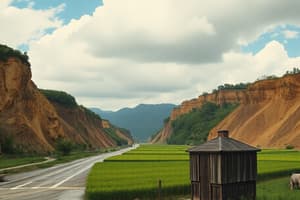Podcast
Questions and Answers
What defines a natural disaster?
What defines a natural disaster?
- Events only related to storms and floods
- Occur as a result of natural processes (correct)
- Events caused by human activities
- Events that have minimal impact on society
Which term describes a natural process that directly threatens the human environment?
Which term describes a natural process that directly threatens the human environment?
- Hazard (correct)
- Catastrophe
- Disaster
- Event
How is a disaster different from a hazard?
How is a disaster different from a hazard?
- Disasters occur over a limited time in a defined area (correct)
- Hazard does not result in property damage
- Hazard is the effect of a disaster
- Disasters do not involve human interaction
What is the defining characteristic of a catastrophe?
What is the defining characteristic of a catastrophe?
Which of the following is NOT an example of a natural disaster?
Which of the following is NOT an example of a natural disaster?
What term is used to describe an event that becomes hazardous when it threatens human interests?
What term is used to describe an event that becomes hazardous when it threatens human interests?
What is the primary difference between weather- and climate-driven natural disasters?
What is the primary difference between weather- and climate-driven natural disasters?
How is the risk of a natural disaster calculated?
How is the risk of a natural disaster calculated?
What are some long-term health consequences that natural disasters can lead to?
What are some long-term health consequences that natural disasters can lead to?
Why are better mitigation efforts required to address the rising costs of natural disasters?
Why are better mitigation efforts required to address the rising costs of natural disasters?
In which geographic regions are some natural disasters more likely to occur with seasonal regularity?
In which geographic regions are some natural disasters more likely to occur with seasonal regularity?
What effect is climate change having on natural disasters?
What effect is climate change having on natural disasters?
Flashcards are hidden until you start studying
Study Notes
Understanding Natural Disasters: What They Are, How They Differ, and Their Impact on Society
Natural disasters are extreme, sudden events caused by environmental factors such as storms, floods, droughts, fires, and heatwaves. They are now occurring with increasing severity, scope, and impact, posing long-term health consequences for people and the environment. In this article, we will explore the nature of natural disasters, their differences, and their impact on society.
What is a Natural Disaster?
A natural disaster is an event that occurs as a result of natural processes, such as storms, floods, droughts, wildfires, and other environmental factors. These disasters are not caused by human activities but can lead to significant damage to human life, property, and infrastructure.
Understanding the Difference Between Hazards, Disasters, and Catastrophes
- A hazard is any natural process or event that directly threatens the human environment. The event itself is not a hazard; it becomes a hazard when it threatens human interests.
- A disaster is the effect of a hazard on society, usually an event that occurs over a limited time in a defined geographic area. It is used when the interaction between humans and a natural process results in significant property damage, injuries, or loss of life.
- A catastrophe is a massive disaster that significantly impacts the human environment and requires considerable time, money, and resources for response and recovery.
Examples of Natural Disasters
Natural disasters can be classified into weather- and climate-driven events and Earth-driven events. Examples of the former include hurricanes, tornadoes, and blizzards, while examples of the latter include earthquakes and volcanic eruptions.
Natural Disasters and Risk Assessment
The risk of a natural disaster occurring in a specific area is defined as the probability of a disaster multiplied by the consequence to human lives and destruction. This risk assessment helps in preparing for natural hazards by determining the potential risk a location has for any disaster.
The Impact of Natural Disasters on Society
Natural disasters can have devastating effects on society, causing significant damage to human life, property, and infrastructure. They can also lead to long-term health consequences, such as cardiorespiratory disease due to poor air quality from fires or trauma from flooding.
The Rising Costs of Natural Disasters
The financial and human cost of natural disasters is rising, and better mitigation efforts are required to help prepare for these disasters. This includes proper building and zoning codes, first responder preparedness, and public education.
Frequency and Disaster Patterns
Certain types of natural disasters are more likely to occur in specific geographic regions, and in some places, these events occur with seasonal regularity, such as the spring tornado season in the United States or the summer-and-fall hurricane season in the Atlantic Ocean.
The Role of Climate Change in Natural Disasters
Climate change is increasing the frequency of weather- and climate-related events, such as droughts, heat waves, increasingly intense hurricanes, and flooding due to sea-level rise.
Conclusion
In conclusion, natural disasters are extreme, sudden events caused by environmental factors that can have devastating effects on human life, property, and infrastructure. Understanding the difference between hazards, disasters, and catastrophes, as well as the risk assessment and impact on society, is crucial for effective preparedness and response to these events.
Studying That Suits You
Use AI to generate personalized quizzes and flashcards to suit your learning preferences.




